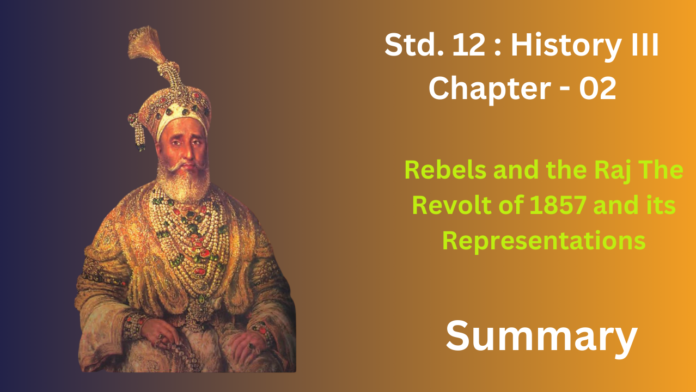“Rebels and the Raj” analyzes the 1857 Revolt’s causes (economic, social, religious, political, triggered by greased cartridges), key events, and the contrasting British and Indian perceptions. The British depicted it as a sepoy mutiny by fanatics seeking a barbaric past, portraying rebels as savage and themselves as saviors. Indians viewed it as a war for independence, with heroes as martyrs. The chapter also examines the complexities of these representations and the varied participation. Ultimately, it highlights the revolt’s legacy in shaping Indian nationalism and the independence movement, emphasizing its memory as crucial for anti-colonial resistance and nation-building.
Exercise
1. Why did the mutinous sepoys in many places turn to erstwhile rulers to provide leadership to the revolt?
Ans:
During the 1857 Revolt, mutinous sepoys often sought leadership from former rulers due to their symbolic authority and legitimacy, representing a pre-colonial order and galvanizing wider support. Secondly, the sepoys often lacked organized leadership and clear political aims beyond immediate grievances, and these rulers offered experience in governance and a potential vision for the future. Thirdly, a shared grievance against the British due to annexation and undermined authority fostered a natural alliance, with both groups hoping for a return to a more favorable order. In some cases, popular pressure also compelled these rulers to assume leadership.
2. Discuss the evidence that indicates planning and coordination on the part of the rebels.
Ans:
Evidence suggesting rebel planning in 1857 includes the synchronized timing of uprisings, the symbolic march towards Delhi, the role of widespread rumors in psychologically mobilizing people, and instances of communication between sepoy units and the establishment of local councils. However, the revolt was notably lacking in central leadership and a cohesive, overarching plan, evident in its regional variations. 1 Coordination efforts were primarily localized, often fueled by shared grievances rather than a carefully orchestrated conspiracy. Therefore, while elements of planning existed, the revolt is more accurately characterized as a widespread collection of localized uprisings.
3. Discuss the extent to which religious beliefs shaped the events of 1857.
Ans:
Religious beliefs were a major factor in the 1857 Revolt, both as an immediate cause and a unifying force. The rumor about cow and pig fat in the greased cartridges ignited outrage among Hindu and Muslim sepoys, who saw it as a deliberate act of religious defilement and a forced conversion attempt.
Deeper religious anxieties also played a significant role. The activities of Christian missionaries, supported by the British, sparked fears of mass conversions. British social reforms, though progressive, were viewed by some as attacks on traditional religious customs. Western education was also suspected as a tool for Christianization.
While religious issues were a powerful unifying element against perceived British interference, the revolt had multiple underlying causes.
In short, religious beliefs, particularly the greased cartridge controversy and broader anxieties about religious subjugation, were a critical catalyst and unifying force in the 1857 Revolt, though other factors also contributed to the widespread rebellion.
4. What were the measures taken to ensure unity among the rebels?
Ans:
Unity in the diverse 1857 Revolt was fostered through appeals to common grievances against British economic exploitation, land policies, and perceived threats to religious and cultural practices. The symbolic leadership of Bahadur Shah Zafar, embodying pre-colonial authority, garnered support across different communities. Proclamations in local languages stressed a joint struggle against the British, and rebels often showed respect for each other’s religious feelings, exemplified by bans on cow slaughter. The revolt was presented as a mutual fight with shared consequences. Despite the absence of a central command, local leaders coordinated actions, and the overarching aim of expelling the British provided a general sense of unified purpose.
5. What steps did the British take to quell the uprising?
Ans:
The British quelled the 1857 uprising with a strong military force, brutally suppressing it and retaking key areas under effective commanders. They strategically allied with loyal Indian rulers and exploited the rebels’ lack of unified leadership and existing social divisions. After the revolt, the British reorganized the army to lessen sepoy unity and increase British numbers, transferred governance from the East India Company to the Crown, became more cautious with social reforms, and implemented a “divide and rule” policy to prevent future unified resistance, thus strengthening their authority.
6. Why was the revolt particularly widespread in Awadh? What prompted the peasants, taluqdars and zamindars to join the revolt?
Ans:
The 1857 Revolt was particularly widespread in Awadh due to deep resentment following the British annexation in 1856, widely seen as unjust given the popular Nawab Wajid Ali Shah.
The annexation severely impacted the taluqdars, large landholders who lost significant power, autonomy, land, and status due to the British Summary Settlement of 1856. This loss fueled their strong opposition and active leadership in the revolt.
Awadh’s peasants also had major grievances due to increased British land revenue demands and the removal of taluqdars, who had offered some protection against harsh taxation. This economic hardship led to widespread peasant participation, targeting both the British and moneylenders.
Even zamindars and others who benefited under the Nawab faced reduced privileges and uncertain futures. The dismantling of the Nawab’s court caused unemployment among officials, artisans, and soldiers, creating widespread discontent.
Essentially, the annexation created a convergence of grievances across Awadh’s social strata, uniting them against British rule. The perceived illegitimacy of the annexation, the elite’s loss of power, and the peasantry’s economic distress made Awadh a prime location for a widespread and intense revolt in 1857.
7. What did the rebels want? To what extent did the vision of different social groups differ?
Ans:
The primary aim of the 1857 rebels was to overthrow British rule, but their visions for the future varied by social group. Sepoys, initially focused on religious and army grievances, broadened their goal to ending British rule. Peasants desired relief from high revenue and debt. Religious leaders aimed to protect their faiths and culture.
While united against the British, these groups lacked a single vision for the post-colonial future. Rulers wanted their authority restored, peasants sought agrarian justice, artisans desired economic protection, and religious leaders wanted cultural preservation. These diverse aspirations presented a significant challenge to establishing a unified post-British order.
8. What do visual representations tell us about the revolt of 1857? How do historians analyse these representations?
Ans:
Visual representations of the 1857 Revolt provide biased insights into British and Indian viewpoints. These visuals reveal each side’s values and desired historical memory of the revolt.
Historians critically analyze these images by considering the creator, context, perspective, intended message, symbolism, and comparison with other sources. They recognize inherent biases and interpret them as constructed narratives serving specific agendas, whether colonial justification or nationalist inspiration. Examining the evolution of these representations over time further reveals shifting interpretations of the revolt.
9. Examine any two sources presented in the chapter, choosing one visual and one text, and discuss how these represent the point of view of the victor and the vanquished.
Ans:
Paton’s “In Memoriam” visually presents the British victor’s narrative, depicting Indian rebels as savage attackers of innocent civilians, thereby justifying the brutal British response. This reinforced colonial portrayals of the “barbaric native” and the necessity of British order.
They emphasize grievances like religious interference and economic exploitation, appealing for Hindu-Muslim unity against the British “foreigners” to safeguard their faith, honor, and land, revealing motivations beyond mere military rebellion and a desire for self-rule.
This contrast illustrates the victor’s justification of violence against a dehumanized enemy versus the vanquished’s articulation of oppression and a call for unity against a common oppressor, highlighting the power dynamics inherent in historical representation.


